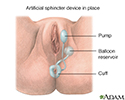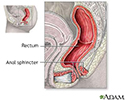Inflatable artificial sphincter
Artificial sphincter (AUS) - urinary
Sphincters are muscles that allow your body to hold in urine. An inflatable artificial (man-made) sphincter is a medical device. This device keeps urine from leaking. It is used when your urinary sphincter no longer works well. When you need to urinate, the cuff of the artificial sphincter can be relaxed. This allows urine to flow out.
Other procedures to treat urine leakage and incontinence include:
-
Anterior vaginal wall repair
Anterior vaginal wall repair
Anterior vaginal wall repair is a surgical procedure. This surgery tightens the front (anterior) wall of the vagina.
 ImageRead Article Now Book Mark Article
ImageRead Article Now Book Mark Article -
Urethral bulking with artificial material
Urethral bulking with artificial materi...
Injectable implants are injections of material into the urethra to help control urine leakage (urinary incontinence) caused by a weak urinary sphinct...
Read Article Now Book Mark Article -
Retropubic suspension
Retropubic suspension
Retropubic suspension is surgery to help control stress incontinence. This is urine leakage that happens when you laugh, cough, sneeze, lift things,...
Read Article Now Book Mark Article -
Tension-free vaginal tape
Tension-free vaginal tape
Placement of tension-free vaginal tape is surgery to help control stress urinary incontinence. This is urine leakage that happens when you laugh, co...
Read Article Now Book Mark Article
Description
This procedure may be done while you are under:
-
General anesthesia
: You will be asleep and unable to feel pain.
General anesthesia
General anesthesia is treatment with certain medicines that puts you into a deep sleep so you do not feel pain during surgery. After you receive the...
Read Article Now Book Mark Article -
Spinal anesthesia
: You will be awake, but you will be numb from the waist down and you will not feel pain. You will be given medicines to help you relax.
Spinal anesthesia
Spinal and epidural anesthesia are medicines that numb parts of your body to block pain. They are given through shots in or around the spine....
Read Article Now Book Mark Article
An artificial sphincter has 3 parts:
- A cuff, which fits around your urethra. The urethra is the tube that carries urine from your bladder to the outside of your body. When the cuff is inflated (full), the cuff closes off your urethra to stop urine flow or leakage.
- A balloon, which is placed under your belly muscles. It holds the same liquid as the cuff.
- A pump, which relaxes the cuff by moving fluid from the cuff to the balloon.
A surgical cut will be made in one of these areas so that the cuff can be put in place:
- Scrotum (men)
- Labia (women)
- Lower belly (men and women)
The pump can be placed in a man's scrotum. It can also be placed underneath the skin in a woman's lower belly or leg.
Once the artificial sphincter is in place, you will use the pump to empty (deflate) the cuff. Squeezing the pump moves fluid from the cuff to the balloon. When the cuff is empty, your urethra opens so that you can urinate. The cuff will re-inflate on its own in 90 seconds.
Why the Procedure Is Performed
Man-made sphincter surgery is done to treat stress incontinence. Stress incontinence is a leakage of urine. This occurs with activities such as walking, lifting, exercising, or even coughing or sneezing.
Stress incontinence
Stress incontinence occurs when your bladder leaks urine during physical activity or exertion. It may happen when you cough, lift something heavy, c...

The procedure is recommended for men who have urine leakage. Leakage can occur after prostate surgery. The man-made sphincter is advised when other medical or surgical treatments do not work.
Women who have urine leakage most often try other treatment options before having an artificial sphincter placed.
Most of the time, your health care provider will recommend drugs and bladder retraining before surgery.
Risks
This procedure is most often safe. Ask your provider about the possible complications.
Risks related to anesthesia and surgery in general are:
- Reactions to medicines
- Breathing problems
- Bleeding, blood clots
- Infection
Risks for this surgery may include:
- Damage to the urethra, bladder, or vagina
- Difficulty emptying your bladder, which may require a catheter
- Urine leakage that may get worse
- Failure or wearing away of the device that requires surgery to remove it
Before the Procedure
Always tell your provider what medicines you are taking. Also let the provider know about the over-the-counter medicines, herbs and supplements that you bought without a prescription.
During the days before the surgery:
- You may be asked to stop taking aspirin, ibuprofen (Advil, Motrin), warfarin (Coumadin), and any other drugs that make it hard for your blood to clot.
- Ask your provider which drugs you should still take on the day of your surgery.
On the day of your surgery:
- You will usually be asked not to drink or eat anything for 6 to 12 hours before the surgery.
- Take the drugs your provider told you to take with a small sip of water.
- Your provider will tell you when to arrive at the hospital.
Your provider will test your urine. This will make sure you do not have a urinary infection before starting your surgery.
After the Procedure
You may return from surgery with a catheter in place. This catheter will drain urine from your bladder for a little while. It will be removed before you leave the hospital.
Catheter
A urinary catheter is a tube placed in the body to drain and collect urine from the bladder.
You will not use the artificial sphincter for a while after surgery. This means you will still have urine leakage. Your body tissues need this time to heal.
About 6 weeks after surgery, you will be taught how to use your pump to inflate your artificial sphincter.
You will need to carry a wallet card or wear medical identification. This tells providers you have a man-made sphincter. The sphincter must be turned off if you need to have a urinary catheter placed.
Women may need to change how they do some activities (such as bicycle riding), since the pump is placed in the labia.
Outlook (Prognosis)
Urinary leakage decreases for many people who have this procedure. However, there may still be some leakage. Over time, some or all of the leakage may come back.
There may be a slow wearing away of the urethra tissue under the cuff. This tissue may become spongy. This may make the device less effective. If your incontinence comes back, changes may be made to the device to correct it.
References
Adams MC, Joseph DB, Thomas JC. Urinary tract reconstruction in children. In: Wein AJ, Kavoussi LR, Partin AW, Peters CA, eds. Campbell-Walsh Urology . 11th ed. Philadelphia, PA: Elsevier; 2016:chap 145.
Chapple CR. Retropubic suspension surgery for incontinence in women. In: Wein AJ, Kavoussi LR, Partin AW, Peters CA, eds. Campbell-Walsh Urology . 11th ed. Philadelphia, PA: Elsevier; 2016:chap 82.
Wessells H, Peterson A. Surgical procedures for sphincteric incontinence in the male: artificial genitourinary sphincter and perineal sling. In: Wein AJ, Kavoussi LR, Partin AW, Peters CA, eds. Campbell-Walsh Urology . 11th ed. Philadelphia, PA: Elsevier; 2016:chap 91.
-
Inflatable artificial sphincter - illustration
An artificial rectal sphincter is used to treat fecal (bowel) incontinence caused by neurological or muscular dysfunction of the anal sphincter.
Inflatable artificial sphincter
illustration
-
Anal sphincter anatomy - illustration
The muscles in the anal sphincter are used in the process of defecation.
Anal sphincter anatomy
illustration
-
Inflatable artificial sphincter - series
Presentation
-
Inflatable artificial sphincter - illustration
An artificial rectal sphincter is used to treat fecal (bowel) incontinence caused by neurological or muscular dysfunction of the anal sphincter.
Inflatable artificial sphincter
illustration
-
Anal sphincter anatomy - illustration
The muscles in the anal sphincter are used in the process of defecation.
Anal sphincter anatomy
illustration
-
Inflatable artificial sphincter - series
Presentation
Review Date: 5/23/2016
Reviewed By: Jennifer Sobol, DO, urologist with the Michigan Institute of Urology, West Bloomfield, MI. Review provided by VeriMed Healthcare Network. Also reviewed by David Zieve, MD, MHA, Isla Ogilvie, PhD, and the A.D.A.M. Editorial team.








